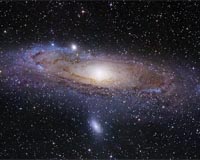 |
Kingston, Canada (SPX) Sep 08, 2009 An international team of astronomers, including Queen's University physicist Larry Widrow, have uncovered evidence of a nearby cosmic encounter. Their study indicates that the Andromeda and Triangulum galaxies, the two galaxies closest to our own, collided about two to three billion years ago. "The encounter forever changed the structure of the galaxies," says Dr. Widrow, a professor of Physics, Engineering Physics and Astronomy at Queen's. "The collision between the galaxies appears to have caused millions of stars to be ripped from the Triangulum disk to form a faint stream visible in the PAndAS data." Dr. Widrow, along with John Dubinsky of the University of Toronto, recreated this galactic encounter using a high performance computer and theoretical modeling. Their simulations illustrate how the strong gravitational field of Andromeda could have pulled stars away from the Triangulum disk creating a stream just as the team saw. The Pan-Andromeda Archeological Survey (PAndAS), led by Alan McConnachie of the Herzberg Institute of Astrophysics in Victoria BC, is using the Canada-France-Hawaii telescope to map the Andromeda and Triangulum galaxies. This map, the largest of its kind, will allow astronomers to test the hypothesis that galaxies grow by "cannibalizing" other galaxies. The findings from the first year of the survey are published this week in the international journal, Nature. Galaxies are large collections of stars, often distributed in a disk-like pattern with spiral arms. Nearly 40 years ago, astronomers learned that galaxies are embedded in extended halos of dark matter. "Our observations now show that stars also inhabit these outer halos," says Dr. Widrow. "We believe that these stars are relics of small galaxies that were destroyed by the powerful tidal fields of a larger galaxy. Our observations also suggest that the Triangulum Galaxy is being ripped apart by Andromeda." Andromeda, and our own galaxy the Milky Way, are the two largest members of a small cluster of galaxies known as the Local Group. Triangulum, the third largest member of the Local Group, is about one-tenth the size of Andromeda. "Within a few billion years Triangulum will be completely destroyed by Andromeda and its stars will be dispersed throughout the Andromeda halo," says Dr. Widrow. "And a few billion years after that, Andromeda and the Milky Way will collide and merge together to form a giant elliptical galaxy." Dr. Widrow is funded by a Discovery Grant with the Natural Sciences and Engineering Research Council of Canada (NSERC). Share This Article With Planet Earth
Related Links Queen's University Astronomy News from Skynightly.com
 Astronomy Question Of The Week: How Can There Be Clouds In Space
Astronomy Question Of The Week: How Can There Be Clouds In SpaceBonn, Germany (SPX) Sep 02, 2009 There are many different kinds of clouds in space, but none of them have anything to do with what we know as clouds on Earth - which are made out of tiny droplets of water. Originally - before the invention of the telescope - astronomers referred to all the shining, extended structures without clearly defined edges that they saw in space as 'clouds' (nebulae in Latin). Since even ... read more |
|
| The content herein, unless otherwise known to be public domain, are Copyright 1995-2009 - SpaceDaily. AFP and UPI Wire Stories are copyright Agence France-Presse and United Press International. ESA Portal Reports are copyright European Space Agency. All NASA sourced material is public domain. Additional copyrights may apply in whole or part to other bona fide parties. Advertising does not imply endorsement,agreement or approval of any opinions, statements or information provided by SpaceDaily on any Web page published or hosted by SpaceDaily. Privacy Statement |